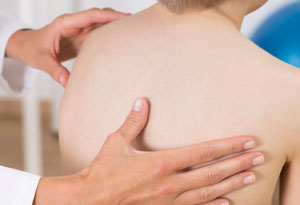What is Vertebral Body Tethering?
Vertebral body tethering (VBT) is used to treat adolescent idiopathic scoliosis (AIS). This treatment changes the growth of the spine to correct scoliosis. It allows the spine to continue to grow during this treatment.
During this surgery, a strong cord called a tether is attached to the spine. The cord causes the spine to straighten as a patient grows. This cord is flexible, so patients with vertebral body tethering can keep some flexibility in their spine. This is a major advantage of this procedure.
The FDA approved vertebral body tethering for use in children in August 2019. A surgeon may recommend vertebral body tethering based on several things, including:
- The degree of your child’s spinal curve.
- How much more growing your child has left to do. This is called skeletal maturity. People reach skeletal maturity at different ages. For girls, it's often between ages 13-15, and for boys, it is around ages 15-17.
How Does Vertebral Body Tethering Work?
During vertebral body tethering surgery, surgeons attach bone screws to the spine. Then they attach the tether to the screws. Tension is applied to the tether to straighten the spine.
Right after surgery, the spinal curve shows improvement. The curve will continue to improve as the child grows and the spine adjusts to the tension on the tether.
The tether stays in the body unless a problem occurs, such as overcorrection of the curve.
Vertebral body tethering is most often used in children and teens who:
- Are ages 9 and up, and
- Have a curve of 45 to 65 degrees
- And are still growing
Before VBT Surgery
Besides the usual testing for any major surgery, your child will have a pulmonary function test to see how well the lungs work. Your child will also have a series of X-rays taken to get measurements and to check the flexibility of the spinal curve. You will have a detailed visit with your surgeon. They will cover what you need to know before, during and after surgery.
Your child will be put to sleep (have anesthesia) before the vertebral body tethering surgery starts.
During VBT Surgery
At Cincinnati Children’s, vertebral body tethering is done with an orthopaedic surgeon and a thoracic surgeon working together in the operating room.
The surgeons make a few small openings (incisions) between your child’s ribs. They place a tiny camera through the chest cavity. Then they place special screws along your child’s spine to hold the tether in place. They attach the tether to the screws. The tether is pulled tight to help correct the curve in the spine.
It normally takes about four to six hours to complete the surgery.
After VBT Surgery
Your child will have a chest tube to drain fluid out of the chest cavity. X-rays will be taken to record the change in your child’s spinal curve. This x-ray will also check on the lungs. Your child will work with a physical therapist on daily activities and breathing exercises.
Most children go home the second or third day after surgery. Patients feel “back to normal” within one to two weeks after surgery. They usually return to school within two to four weeks after surgery.
Two weeks after surgery, your child will have a physical therapy appointment. The therapists will check your child’s range of motion and strength. At that time, additional physical therapy might be recommended. But most of the time, further physical therapy is not needed.
Your child will need to limit extreme activity (such as skateboarding, gymnastics, jumping on a trampoline) and sports the first three to four months after surgery.
Outcomes
For patients with vertebral body tethering, who have reached skeletal maturity, short- to mid-term outcomes are good. They experience a good range of motion in the spine, and their overall quality of life is improved.
Sometimes a second surgery is needed if:
- Bone screws become loose
- There is too much or too little tension in the tether
- The tether breaks
- The curve overcorrects
- The curve doesn’t respond to tethering
If a child’s curve does not respond to tethering, a spinal fusion surgery might be needed.
Those who are treated for other disorders, in addition to scoliosis, may need long-term care into adulthood.
When to Call the Doctor
Call us using the contact information below if your child experiences:
- Pain that doesn’t go away
- Drainage where the incisions were made
- Difficulty breathing




